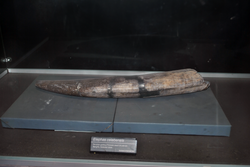Biology:Elephas celebensis
| Elephas celebensis Temporal range: Late Pliocene - Early Pleistocene
| |
|---|---|

| |
| Elephas celebensis fossilized ivory from Sangihe, North Sulawesi, Indonesia. At display in the Bandung Geological Museum | |
| Scientific classification | |
| Domain: | Eukaryota |
| Kingdom: | Animalia |
| Phylum: | Chordata |
| Class: | Mammalia |
| Order: | Proboscidea |
| Family: | Elephantidae |
| Genus: | Elephas |
| Species: | †E. celebensis
|
| Binomial name | |
| †Elephas celebensis Hooijer, 1949
| |
| Synonyms | |
|
Stegoloxodon celebensis Kretzoi, 1950 | |
Elephas celebensis, the Sulawesi dwarf elephant, is an extinct species of elephant.
Description
Elephas celebensis (sometimes referred as Stegoloxodon celebensis) was about half the size of Archidiskodon planifrons, to which both were initially considered to be related by Dirk Albert Hooijer in 1949.[1] The most evident difference with the latter species is the presence of functional lower tusks in some individuals. This was considered to be caused by paedomorphosis, a retention of juvenile characters in the adult stage, by Vincent Maglio in his revision of the proboscideans in 1973.[2] He based his conclusion on the presence of vestigial incisive germs in mandibles of Mammuthus planifrons. This idea was followed by Hooijer in 1974.[3]
Ancestry and taxonomy
The retention of functional lower tusks is, however, not seen in juveniles of otherwise single pair-tusked individuals, so the said characters cannot be considered a paedomorphic feature proper. It is simply a retention of a primitive character, as seen in the African elephantid genera Primelephas and Stegotetrabelodon, and possibly the earliest forms of Elephas planifrons.[citation needed]
Between the late 1980s and early 1990s, an Indonesian-Dutch team excavated more material, including a fairly complete but rather distorted skull. All material, new as well as old, is described and revised in Van den Bergh’s thesis of 1999 on the Indonesian elephantoids, with a discussion on taxonomy.[4] He puts question marks ( as in “Elephas”) to indicate the uncertain taxonomical position, following Paul Sondaar’s approach of 1984.[5] Van den Bergh accepts a possible relation with the supposed “Elephas” indonesicus from Ci Pangglosoran near Bumiayu, Java, dated to the same geological period. Also this specimen was originally assigned to Elephas planifrons, but was later renamed Stegoloxodon indonesicus by Kretzoi in 1950.[6] Recently, Georgi Markov and Haruo Saegusa made a further step and synonymized “Elephas” with Stegoloxodon in 2008.[7]
Distribution
In general, elephantids under the supposed Stegoloxodon group has been known to be restricted to Java[8] and Sulawesi. The exact relations between the two species is somewhat unclear, since the Javan species is only known from a single molar.
Specifically, fossils of E. celebensis have been found in the Walanea Formation, dated to the Late Pliocene - Early Pleistocene.[citation needed]
References
- ↑ Hooijer, D.A .(1949). Pleistocene Vertebrates from Celebes. IV. - Archidiskodon celebensis nov spec. Zoologische Mededelingen, Museum Leiden 30: 205–226.
- ↑ Maglio, V.J. (1973). Origin and evolution of the Elephantidae. Transactions of the American Philosophical Society Philadelphia Volume 63. American Philosophical Society, Philadelphia. Pp. 149
- ↑ Hooijer, D.A. (1974). Elephas celebensis (Hooijer) from the Pleistocene of Java. Zoologische Mededelingen, Museum Leiden, 48: 85–93.
- ↑ Bergh, G.D. van den, 1999. The Late Neogene elephantoid-bearing faunas of [Indonesia and their palaeozoogeographic implications; A study of the terrestrial faunal succession of Sulawesi, Flores and Java, including evidence for early hominid dispersal east of Wallace's line, Scripta Geologica 117: 1-419 [1]
- ↑ Sondaar, P.Y., 1984. Faunal evolution and the mammalian biostratigraphy of Java. Courier Forschungsinstitut Senckenberg 69: 219-235.
- ↑ Kretzoi, M., 1950. Stegoloxodon nov. gen., a loxodonta elefantok esetleges azsiai ose (Stegoloxodon nov. gen., a possible Asiatic ancestor of true loxodonts). Földtani Közlöny 80: 405-408 [In Hungarian and English].
- ↑ Markov, G.N. and Saegusa, H., 2008. On the validity of Stegoloxodon Kretzoi, 1950 (Mammalia: Proboscidea). Zootaxa 1861: 55-56.
- ↑ Van der Maarel, F.H., 1932. Contributions to the knowledge of the fossil mammalian fauna of Java. Wetenschappelijke Mededelingen Dienst van den Mijnbouw in Nederlandsch-Indie 15: 1-208.
Wikidata ☰ Q5359440 entry

